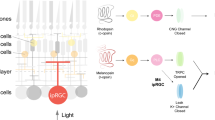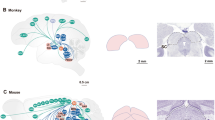Summary
The apical cell coat of the olfactory epithelium proper and the vomeronasal neuroepithelium of the rat was investigated electronmicroscopically by means of the Ruthenium-red reaction. In the olfactory epithelium proper, the cilia of receptor cells and microvilli of supporting cells possess a cell coat measuring approximately 10 nm in thickness. In the vomeronasal neuroepithelium, the apical cell coat is thicker than in the olfactory epithelium proper. On microvilli of vomeronasal receptor cells the cell coat varies in thickness from 15 to 20 nm, and on microvilli of supporting cells it measures approximately 75 nm. The functional implications of these findings are discussed.
Similar content being viewed by others
References
Baldwin KM (1981) Cell-to-cell tracer movement in cardiac muscle. Ruthenium red vs. lanthanum. Cell Tissue Res 221:279–294
Barber PC, Raisman G (1978) Cell division in the vomeronasal organ of the adult mouse. Brain Res 141:57–66
Beets MGJ (1978) Structure-activity relationships in human chemoreception. Applied Science Publishers Ltd, London
Blanquet PR (1976a) Ultrahistochemical study on the ruthenium red surface staining. I. Processes which give rise to electron-dense marker. Histochemistry 47:63–78
Blanquet PR (1976b) Ultrahistochemical study on the ruthenium red surface staining. II. Nature and affinity of the electron dense marker. Histochemistry 47:175–189
Boelens H (1976) Molecular structure and olfactive properties. In: Benz G (ed) Structureactivity relationships in chemoreception. Information Retrieval Ltd, London, pp 197–210
Breipohl W, Mendoza AS, Miragall F (1982) Freeze-fracturing studies on the main and vomeronasal olfactory sensory epithelia in NMRI-mice. In: Breipohl W (ed) Olfaction and endocrine regulation. Information Retrieval Ltd, London, pp 309–322
Breipohl W, Ohyama M (1981) Comparative and developmental SEM studies on olfactory epithelia in vertebrates. (Biomedical aspects and speculations) Biomed Res 2:Suppl. 437–448
Chien S, Laufer L, Handley DA (1982) Vesicle distribution in the arterial endothelium determined with ruthenium red as an extracellular marker. J Ultrastruct Res 79:198–206
Dodd GH (1976) Ligand-binding phenomena in chemoreception. In: Benz G (ed) Structureactivity relationships in chemoreception. Information Retrieval Ltd, London, pp 55–63
Getchell TV, Getchell ML (1977) Histochemical localization and identification of secretory products in salamander olfactory epithelium. In: Le Magnen J, MacLeod P (eds) Olfaction and taste VI. Information Retrieval Ltd, London, pp 105–112
Gnatzy W, Weber KM (1978) Tormogen cell and receptor-lymph space in insect olfactory sensilla. Cell Tissue Res 189:549–554
Graziadei PPC, Monti-Graziadei GA (1978) Continuous nerve cell renewal in the olfactory system. In: Jacobson M (ed) Handbook of sensory physiology Vol. IX Development of sensory systems. Springer, Berlin, pp 55–83
Herberhold C (1969) Adsorption von Geruchssubstanzen auf Thermistoren. Archiv Klin Exp Ohren-Nasenund Kehlkopfheilk 194:435–440
Kafka WA (1976) Energy transfer and odor recognition. In: Benz G (ed) Structure-activity relationships in chemoreception. Information Retrieval Ltd, London, pp 123–135
Keil T (1979) Rutheniumrot-Färbung sensorischer Einheiten der Insekten-Epidermis. Eur J Cell Biol 19:78–82
Luciano L, Reckheimer G, Engelhardt W, Reale E (1982) Physiologische und morphologische Unterschiede zwischen proximalem und distalem Colonepithel beim Meerschweinchen. Verh Anat Ges 77 (in press)
Luft JH (1971a) Ruthenium red and violet. I. Chemistry, purification, methods of use for electron microscopy and mechanism of action. Anat Rec 171:347–368
Luft JH (1971b) Ruthenium red and violet. II. Fine structural localization in animal tissues. Anat Rec 171:369–416
Luft JH (1976) The structure and properties of the cell surface coat. Int Rev Cytol 45:291–382
Martinez-Palomo A (1970) The surface coats of animal cells. Int Rev Cytol 29:29–75
Mendoza AS (1980) The cell coat of the developing olfactory epithelium in the chick. Cell Tissue Res 207:227–232
Meredith M (1982) Stimulus access and other processes involved in nasal chemosensory function: potential substrates for neural and hormonal influence. In: Breipohl W (ed) Olfaction and endocrine regulation. Information Retrieval Ltd, London, pp 223–236
Miragall F, Mendoza AS (1982) Intercellular junctions in the rat vomeronasal neuroepithelium. A freeze-fracture study. J Submicrosc Cytol 14:597–605
Miragall F, Mendoza AS, Breipohl W (1982) Intercellular junctions of the main and vomeronasal olfactory sensory epithelia in rodents. A freeze-fracture study. Verh Anat Ges 77 (in press)
Moulton DG (1975) Cell renewal in the olfactory epithelium of the mouse. In: Denton DA, Coghlan JP (eds) Olfaction and taste V. Academic Press, New York, pp 111–114
Rehn B, Breipohl W, Schmidt C, Schmidt U, Effenberger F (1981) Chemical blockade of olfactory perception by N-methyl-formimino-methylester in albino mice. II. Light microscopical investigations. Chemical Senses 6:317–328
Rehn B, Breipohl W, Naguro T, Schmidt U (1982) Effect of N-methyl-formimino-methylester on the vomeronasal neuroepithelium of mice. Cell Tissue Res 225:465–468
Reynolds ES (1963) The use of lead citrate at high pH as an electron-opaque stain in electron microscopy. J Cell Biol 17:208–212
Robenek H, Rassat J, Themann H (1981) A quantitative freeze-fracture analysis of gap and tight junctions in the normal and cholestatic human liver. Virchows Arch (Cell Pathol) 38:39–56
Schmidt C, Schmidt U, Breipohl W, Effenberger L (1980) Inhibited olfactory reception in laboratory mice by N-methyl-formimino-methylester. In: van der Starre H (ed) Olfaction and taste VII. Information Retrieval Ltd, London, pp 405
Thurm U (1972) The generation of receptor potentials in epithelial receptors. In: Schneider D (ed) Olfaction and taste IV. Wissenschaftliche Verlagsgesellschaft, Stuttgart, pp 95–101
Wysocki CHJ, Wellington JL, Beauchamp GK (1980) Access of urinary nonvolatiles to the mammalian vomeronasal organ. Science 207:781–783
Author information
Authors and Affiliations
Additional information
A portion of this study was presented at the 6th European Anatomical Congress in Hamburg. This publication is dedicated to Prof. E. Klika
Supported by the Deutsche Forschungsgemeinschaft (Br 358/5-1).
Rights and permissions
About this article
Cite this article
Mendoza, A.S., Breipohl, W. The cell coat of the olfactory epithelium proper and vomeronasal neuroepithelium of the rat as revealed by means of the Ruthenium-red reaction. Cell Tissue Res. 230, 139–146 (1983). https://doi.org/10.1007/BF00216034
Accepted:
Issue Date:
DOI: https://doi.org/10.1007/BF00216034




